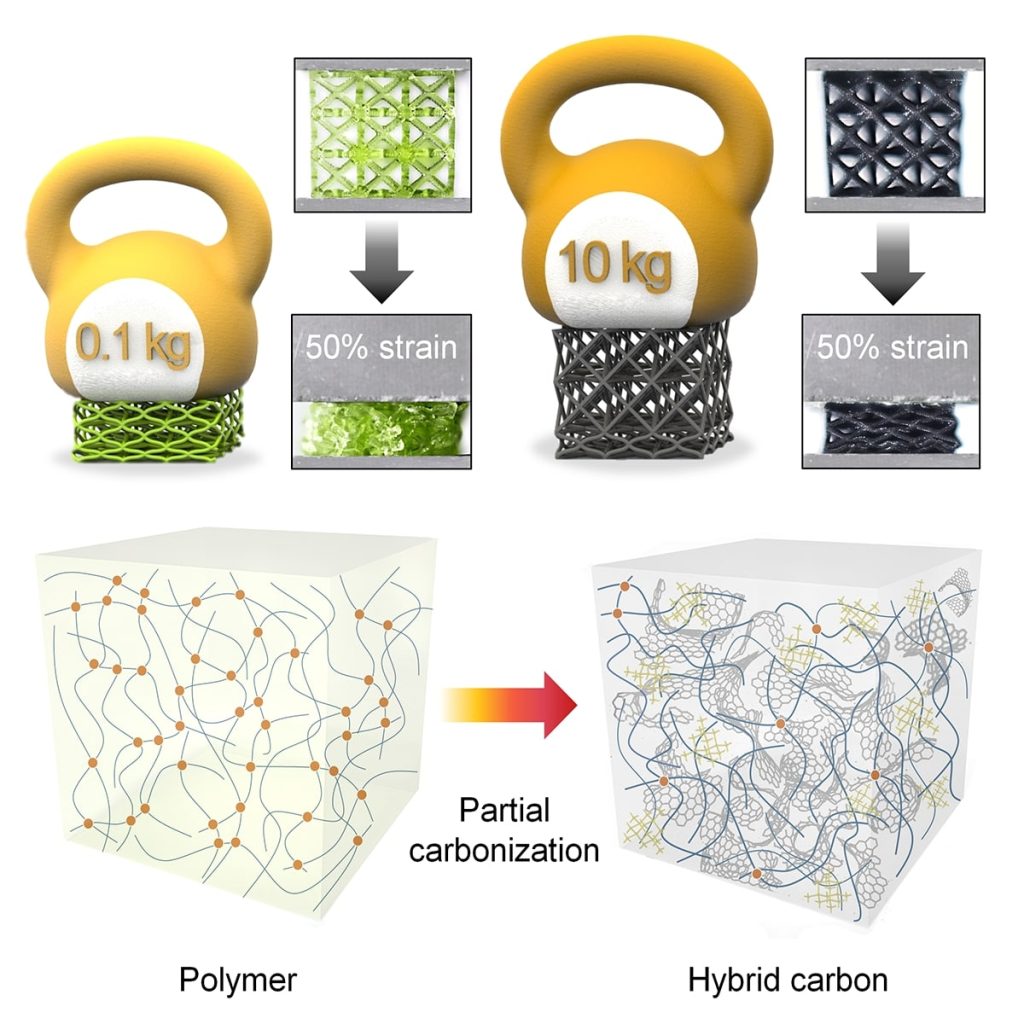Researchers at the City University of Hong Kong (CityU) have come up with a way of making 3D printed polymeric lattice parts 100-times stronger than before.
Compared to traditional heat treatments, which strengthen plastic printed objects at the cost of deformability, the CityU approach only partially carbonizes them, to make them more robust and twice as ductile. Using their process, the team say it could be possible to realize sophisticated 3D prints with mechanical properties tailored to specific applications, such as coronary stents or bio-implants.
“We found a way to convert weak and brittle 3D printed photopolymers into ultra-tough 3D architectures comparable to metals and alloys just by heating them under the right conditions, which is surprising,” says CityU Professor Lu Yang. “Our work provides a low-cost, simple and scalable route for making lightweight, strong and ductile mechanical metamaterials with virtually any geometry.”
Chasing the “holy grail” of materials
According to the CityU scientists, developing a polymer that’s lightweight at the same time as having an ultra-high level of strength and ductility, is considered the “holy grail” of material R&D, but these properties are often “mutually exclusive.”
This is because pyrolysis, a process often used to transform plastic parts into reinforced carbon via heating in an inert atmosphere, deprives the original polymer of almost all its deformability. While the team acknowledges the existence of other plastic-strengthening methods, they say these also lead to an “intrinsic brittleness and low toughness” that “limits [resulting parts’] structural applications.”
In particular, these drawbacks have restricted the manufacture of parts from ‘metamaterials,’ those engineered to have properties not found in naturally-occurring feedstocks. Certain iterations of these can be used to create microlattices, which combine lightweight structural design with the qualities of their constituent materials, but the researchers say their 3D printability remains limited.
“Strong and tough architected components usually require metals or alloys to be 3D printed, but they are not easily accessible owing to the high cost and low resolution of commercial metal 3D printers and raw materials,” adds Yang. “Polymers are more accessible but typically lack mechanical strength or toughness.”

Developing a 100-times tougher polymer
In the course of their research into 3D printing polymeric lattices, the CityU team say they’ve come up with a way of heating them into a “magic-like” state of partial carbonization. By carefully controlling the heating rate, temperature, duration and gas environment of the pyrolysis process, the scientists have found it possible to enhance the stiffness, strength and ductility of microlattices in a single step.
The researchers made their discovery via a series of characterization techniques, which revealed that slow heating leads to incomplete conversion of a material’s polymeric chains during pyrolytic conversion. This yields a hybrid material, in which structurally-reinforcing carbon fragments and loosely cross-linked polymer chains that prevent the composite from fracturing, synergistically coexist.
Through further R&D, the researchers went on to find that the ratio of polymer to carbon fragments is also vital to the production of strength and ductility-optimized parts. Putting their theory to the test, the team created several test prints, in which they were iteratively able to develop a carbonized lattice that’s 100 times stronger and twice as ductile as before.
As an added benefit, the researchers’ ‘hybrid-carbon’ microlattice also showed better biocompatibility than its base polymer, and even proved more capable of supporting cell bioactivity. With this in mind, the team believe their process could be used to widen the functionalities of various other polymers moving forwards, and unlock new medical, robotic and energy device 3D printing materials.

Lattice reinforcement in 3D printing
The concept of developing parts with lattice geometries to reduce weight, while improving their impact absorption and material efficiency, has been around in the 3D printing industry for some time. Introduced in June 2022, nTopology’s new lattice design tools now allow users to apply advanced DfAM techniques to streamline the lattice generation process, and it’s said to have more upgrades in the pipeline.
General Lattice has even been awarded a contract by the US Army to develop 3D printed energy-absorbing combat helmets with advanced lattice geometries. Currently underway at General Lattice’s facility in Chicago, the project has seen the firm develop a predictive modeling toolset for designing and generating improved lattice materials.
At a more experimental level, production service provider Rapid Product Manufacturing (RPM) has been awarded a research grant to develop complex 3D printed lattices for consumer goods applications. Using Carbon Digital Light Synthesis (DLS) technology and EPU41/EPU40 materials, RPM is working to create complex elastic structures that have industrial and consumer goods potential.
The researchers’ findings are detailed in their paper titled “Lightweight, ultra-tough, 3D-architected hybrid carbon microlattices.” The study was co-authored by James Utama Surjadi, Yongsen Zhou, Siping Huang, Liqiang Wang, Maoyuan Li, Sufeng Fan, Xiaocui Li, Jingzhuo Zhou, Raymond H.W. Lam, Zuankai Wang and Yang Lu.
To stay up to date with the latest 3D printing news, don’t forget to subscribe to the 3D Printing Industry newsletter or follow us on Twitter or liking our page on Facebook.
While you’re here, why not subscribe to our Youtube channel? featuring discussion, debriefs, video shorts and webinar replays.
Are you looking for a job in the additive manufacturing industry? Visit 3D Printing Jobs for a selection of roles in the industry.
Featured image shows a set of 3D printed samples that have been treated using the team’s partial-carbonization technique. Image via James Surjadi et al, CityU.



